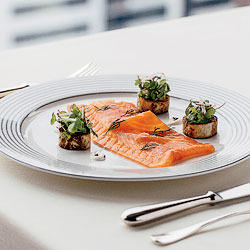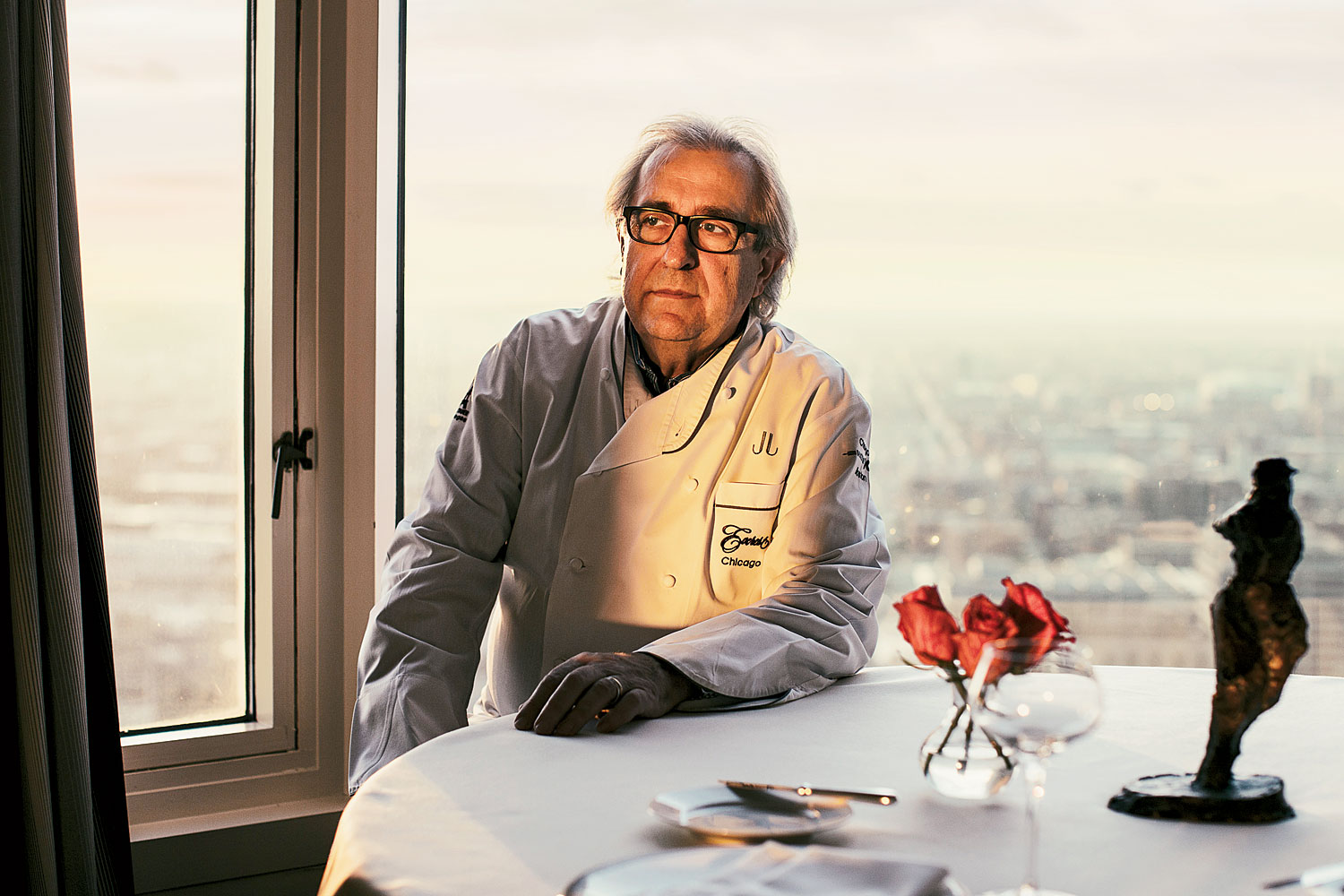I descend back to earth from the 40th floor of the Chicago Stock Exchange, belly full of moulard duck and apple soufflé, bloodstream swimming with Alsatian Riesling, and brain overflowing with questions: Is it Jean Joho’s duty as a four-star chef to push forward? Must his restaurant simply provide the best experience possible, regardless of past glory or present climate? Would it be all right to lie down in the elevator?
All these questions ultimately funnel into a larger one, which, having just spent three luscious hours in one of Chicago’s last surviving upscale restaurants, I feel compelled to address: After 30 years of uninterrupted excellence, does Everest—and old-school establishments like it—still have a place in this world?
By “upscale,” I don’t mean prices. There are now plenty of restaurants—some you’ve probably never heard of—that charge more than Everest. I’m talking about the act of dining out as it once was, a starched and formal ritual where voices remain hushed, elbows stay off the table, the carpet is clean, and the language cleaner. About places where the chef got his start washing dishes at some brasserie in Lyon at the age of eight. Where the wine director doesn’t fake his way through bottles he barely knows, and the waiter doesn’t have a neck beard or a Hüsker Dü tattoo on his forearm. Where the experience is orchestrated by adults for adults.
If the screenplay were to call for a scene in a Fancy Restaurant, you wouldn’t need to change so much as a single Christofle spoon at Joho’s beloved South Loop citadel. Since 1986, the native of Barr, France, has stuck to his guns, producing brainy and rewarding Alsatian food 500 feet above Chicago, racking up awards and respect even as the city below transformed into the kind of town that didn’t cherish that food anymore. Your current favorite chef may not have even been born in 1986. And so Everest, which will never stop serving shirred eggs with osetra caviar in the shell, often gets described as a “treasure.” While this label sounds good, it is actually condescending shorthand for “I’m glad it exists but can’t imagine under what circumstances I would go there.”
On a recent Friday night, half the exclusive room’s 22 tables sat empty. Pervasive mirrors and muted music reflected that emptiness, yet not a hint of desperation tinted the experience. When Joho, his hair as white as his crisp double-breasted jacket, popped out of the kitchen to assess the scene in the dining room, it was as though God himself were surveying his kingdom and liked what he saw.
The Alsace-heavy wine list is still unrivaled, the bronze Soldini sculptures on each table forever endure, and the service, if anything, shines brighter than ever. It’s as if the confident and ever-appropriate staff were finally given permission to have fun; my outstanding waitress had no agenda other than making my party feel good.
Joho shares those aspirations. His unique food has always been a refined interpretation of a very specific regional cuisine—the iconic Franco-Germanic mingling of Alsace—and three decades in, he’s still the only one to plant a flag atop that mountain. But whether you build your own prix fixe meal (three courses or four) or dive into one of Joho’s seasonal seven-course tasting menus, you won’t find much in the way of new dishes up there.
Then again, there’s nothing wrong with playing the hits. The uncanny roasted Maine lobster in a heady mix of Gewürztraminer butter and ginger will go down as one of the great dishes in Chicago history. Take it off the menu and the clientele would storm the kitchen with decanters and butter knives. Same thing with the superb sole meunière perched with capers and Espelette peppers at the edge of a plate spread with a layer of irresistible pommes mousseline. Oh, to experience both dishes again for the first time.

As for the offerings I haven’t explored repeatedly, plenty of those are also sublime. The crusted Berkshire pork cheeks and poached veal tongue (tongue in cheek—get it?) exploit the sauerkrauty tang of a classic Alsatian choucroute salad that’s been neutralized to impressive effect by fresh endives and an acidic sauce ravigote. A thick, intense corn bouillon flows around an island of glorious preserved duck topped with whipped herb butter and brioche croutons.
And Joho knows foie gras better than you know your spouse. The man who has spun the stuff any way you can imagine—over a bed of lentils, as a terrine with marinated figs, on a spiced cake with pineapple quince—captures decadent magic by sautéing it and serving it on cooked Golden Reinette apples with the caramel-toned apéritif Picon Bière.
Not many dishes at Everest miss the mark, so the ones that do really stand out, such as the undercooked carnaroli risotto with crispy sweetbread nuggets and bland Fairytale pumpkin cream. And the inexplicable slow-braised garden zucchini in a green pool of wakame nage, flanked by a traditional seaweed salad and a mass of quinoa fricassee, borders on nonsensical in this context. Are there no good vegetarian dishes in Alsace? Did the kitchen have to go all the way to Japan?
But most everything else is airtight, from the familiar three-part amuse-bouche (pumpkin cream, cauliflower soup, and mushroom pot de crème) to the blitz of petits fours and other mignardises to burst your buttons at meal’s end. Jennifer Schmitt, the gregarious wine director, can’t wait to discuss gems such as a 2001 Lucien Albrecht Riesling Grand Cru Pfingstberg and pour them into gleaming crystal stemware. A fromage blanc apple soufflé with caramel coulis, peanuts, and caramel-maple glacé—a Michelin-ready homage to a caramel apple—attains the snowy ideal of soufflé textures: firm yet soft, rich yet somehow light. It’s like getting buried under a warm avalanche.
The “dishes upon which Everest has built its reputation”—such as the aforementioned lobster—are marked with asterisks on the traditionally designed menu. The practice is tacky, self-congratulatory, and absolutely wonderful. While those creations break no new ground, they’re as noteworthy as they were a decade (or three) ago and deserve to be celebrated.
Joho has spent nearly half his life at Everest and could probably move on to something else. But I for one don’t want Everest to be something else. I want Everest to stay Everest for as long as it can, because there are no other Everests left. The day Joho calls it quits, Chicago loses a big chunk of history.
The game has changed, but Joho, 62, seems content—and savvy enough—to keep playing his old game. Is this restaurant a place to seek out the most creative food in Chicago? No. But I will continue to adore Everest for wrapping me in a cocoon of culinary nostalgia, warmed by a sunset casting an auburn glow over a city I love. To me, a four-star restaurant is one that provides an indelible experience. And regardless of where it fits into the current landscape , or whether it fits in at all, Everest remains as memorable and gratifying as any restaurant in Chicago.
“What’s good today is not good enough tomorrow,” Joho told Chicago in a 2006 interview. An admirable philosophy, and he surely meant it at the time. But at Everest in the year 2016, it seems that yesterday is more than good enough.



